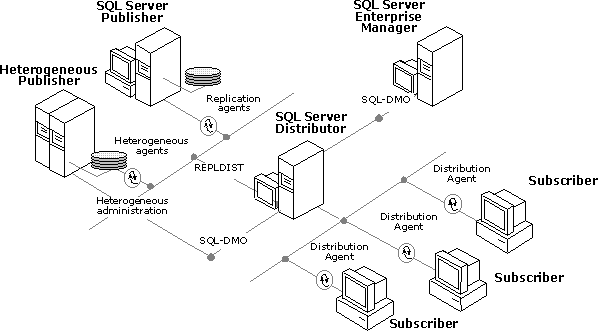
Many organizations must support databases from a wide range of vendors. SQL Server 7.0 supports replication to and from heterogeneous data sources using ODBC or OLE DB. For example, Microsoft Access 2000 supports bidirectional merge replication natively. SQL Server 7.0 supports transactional replication to any heterogeneous Subscriber. Heterogeneous Publishers, however, must support the SQL Merge Agent application programming interface (API) to participate in bidirectional merge replication. For more information about bidirectional merge replication, see SQL Server Books Online.
SQL Server 7.0 includes a SQL Merge control object that manages heterogeneous replication. The SQL Merge control object provides the functionality of the Merge Agent and is used in conjunction with subscriptions to merge publications. The same properties that can be set by invoking the SQL Merge control object are available using the replication Merge Agent utility.
The following illustration shows a heterogeneous replication scenario. In this example, a heterogeneous Publisher is configured to exchange updates with a central SQL Server database. The central SQL Server Publisher then synchronizes changes to the three client Subscribers. All of these Publishers and Subscribers are managed by SQL Server Enterprise Manager using SQL Distributed Management Objects (SQL-DMO).

Sybase Adaptive Server Anywhere 6.0 supports heterogeneous replication through the Sybase Open Client Interface. However, you must use the Sybase Replication Server to gain access to heterogeneous data sources. If you want Replication Server to be a Subscriber to Sybase Adaptive Server Anywhere 6.0, you must use the Replication Agent for Sybase Adaptive Server Enterprise.